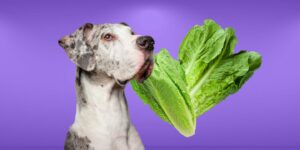Yes, dogs can eat collard greens in moderation. Collard greens are nutritious vegetables that can provide dogs with several health benefits. However, it is important to feed them to your dog in moderation and in small portions to avoid any potential digestive issues.
Nutritional Benefits of Collard Greens for Dogs
Collard greens are a type of cruciferous vegetable, which means they belong to the cabbage family. They are a good source of vitamins A, C, and K, as well as fiber, calcium, and iron. These nutrients can help support your dog's immune system, promote healthy skin and coat, and maintain strong bones and teeth.
Vitamins and Minerals
Vitamin A
Vitamin A is essential for maintaining eye health and supporting the immune system. It helps dogs maintain a healthy skin and coat as well.
Vitamin C
Vitamin C is an antioxidant that can help reduce inflammation and promote a healthy immune system. It can also help dogs combat stress and aid in their overall well-being.
Vitamin K
Vitamin K is important for blood clotting and bone health. This vitamin makes sure that your dog's blood can clot properly and maintains strong bones.
Calcium
Calcium is essential for building and maintaining strong bones and teeth in dogs. It also plays an important role in muscle function, nerve transmission, and hormone secretion.
Iron
Iron is needed for the production of red blood cells and helps transport oxygen throughout the body. It also supports immune function and overall health.
Fiber Content
Collard greens are a good source of fiber, which can help regulate your dog's digestion and promote a healthy gut.
Antioxidants
Collard greens are packed with antioxidants, which can help protect your dog's cells from damage caused by free radicals.
Serving Collard Greens to Dogs
Introducing Collard Greens Gradually
When introducing collard greens to your dog's diet, it is important to do so gradually to avoid digestive upset. Start by adding a small number of cooked collard greens to your dog's regular food and monitor their reaction. If they tolerate it well, you can gradually increase the amount over time.
Cooking Methods
Steaming
Steaming collard greens is a healthy way to cook them, as it retains most of their nutrients. It makes them soft and easy for your dog to digest.
Boiling
Boiling collard greens can also make them soft and easy to digest. However, some nutrients may be lost through the process.
Sauteeing
Sauteeing collard greens in a small amount of oil can make them more palatable for your dog. Be sure to avoid any seasonings that may be harmful to your dog.
Avoiding Seasonings and Additives
It is essential to avoid seasoning the collard greens with ingredients like onions, garlic, or salt, as they can be harmful to dogs.
Potential Dangers of Feeding Collard Greens to Dogs
Digestive Upset
Feeding your dog too much collard greens or introducing them too quickly can cause digestive upset, as dogs may not be able to handle a large amount of fiber.
Kidney Stones
Collard greens are high in calcium oxalates, which may cause kidney stones if consumed in large amounts.
Toxic Ingredients in Canned Collard Greens
Canned collard greens may contain spices like onions and garlic, which are toxic to dogs. Be sure to check the ingredients before feeding canned collard greens to your pet.
Tips for Feeding Collard Greens to Dogs
Monitoring Your Dog's Reaction
Always monitor your dog's reaction when introducing new foods. If your dog shows any signs of discomfort or illness, discontinue feeding collard greens and consult your veterinarian.
Finding the Right Balance
Feed your dog collard greens in moderation to provide nutritional benefits without causing digestive issues or other health problems.
Alternatives to Collard Greens
Other healthy vegetables that are safe for dogs include carrots, green beans, and broccoli. These can be fed in moderation as part of a balanced diet.
Conclusion
In conclusion, collard greens can be a healthy and nutritious addition to your dog's diet in moderation. Just be sure to feed them cooked, in small portions, and avoid adding any seasoning or other potentially harmful ingredients. By following these guidelines, you can help ensure that your dog gets the most nutritional benefits from collard greens while avoiding any potential dangers. Encourage a healthy and varied diet for your dog to maintain their overall well-being.











